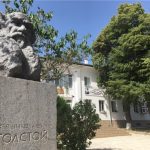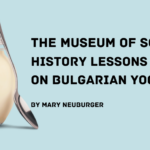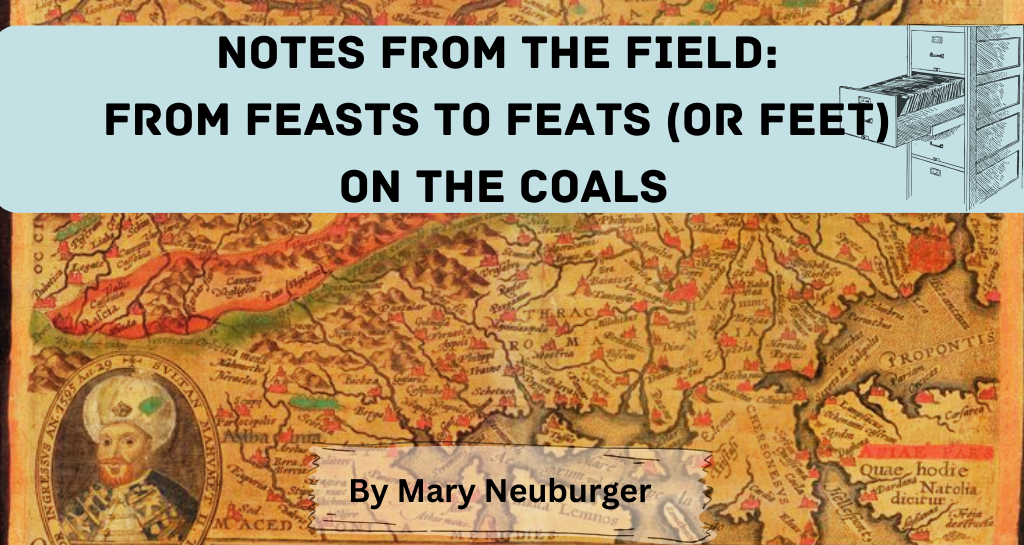
This summer, I conducted research in, but also beyond, my regular haunts, namely the dusty old libraries and archival reading rooms of Sofia, the capital of Bulgaria. After several days in Sofia, I took to the mountains to follow the paths of ethnographers, tourists, and pilgrims who have written about this distant borderland of Europe over the past 200 years. To this day, Bulgaria has remained a kind of distant terra incognita, beckoning “adventure” travelers to the edge of the European continent. All the more reason for travelers – foreign and Bulgarian – to record their journeys, to map the remote physical and cultural recesses of this Balkan periphery, always seemingly “backward,” in transition, and “off the beaten track.”
The veritable sea of travelers’ accounts are among the sources that inform my current book project, a cultural history of food and drink in the Eastern Balkans, with a focus on Bulgaria from the 1860s -1989. Bulgarian foodways were clearly imprinted by the Empires that ruled or influenced the region, from the Ancient Greek, Roman, Byzantine, Ottoman, Russian, Austro-Hungarian, to the Soviet.
Some of these travelers were Bulgarians, mapping their own homeland and defining their own nation as they went, with the culture of food and drink as important components. But many more were foreigners who consumed and assessed food and drink as sources of pleasure and anxiety. They mapped patterns of restraint and gluttony, as well as the connections of food with identity, healing, and magic. They often used practices of food and drink—production, preparation, and etiquette—as a way of forming or confirming their own opinions about locals as savage and barbaric or alternatively as vigorous and sensible. Such accounts include mouth-watering descriptions of home-cooked meals and local inn or restaurant fare from the days of treks on oxen-drawn carts. The denouement of the story is the 1960s and 1970s when cities of leisure grew out of the snake-infested sands of the Bulgarian Black Sea coast to accommodate millions of visitors from both sides of the Iron Curtain. My interest is in the ways that food and drink fit into old and new rituals surrounding leisure and pleasure. As critical to this story, I explore how foreign travelers and local tourists were part of the transformation of such patterns over the last century. I am also particularly interested in patterns of restraint and abstinence, whether they were intellectual movements of the interwar period or state-directed patterns of pleasure and leisure under communism.
One of my plans for this summer was to follow the well-worn paths of my traveller-authors. This led me to one particularly remarkable place, namely to the village of Bulgari in a spectacular mountainous region called the Strandja, which borders Turkey and spills down to the Black Sea coast in southeastern Bulgaria. I planned my visit to Bulgari carefully, so that I would be there on the feast day of Constantine and Elena, June 4 by the Julian calendar, the day when the nestinari or fire-dancers perform their well-known ritual. Numerous foreigners and locals have chronicled their observations of the nestinarstvo — the ritual of waking on hot coals — which reportedly dates back thousands of years to ancient Thracian times. Locals claim that the originally pagan ritual has been practiced more or less continually since that time. Eventually Christianized, nestinarstvo was also passed on to successive waves of Greek and eventually Slavic residents who moved into the region. The practice was once much more widespread, but Bulgari is one of the last places one can still see the practice in its most elaborate enactment.
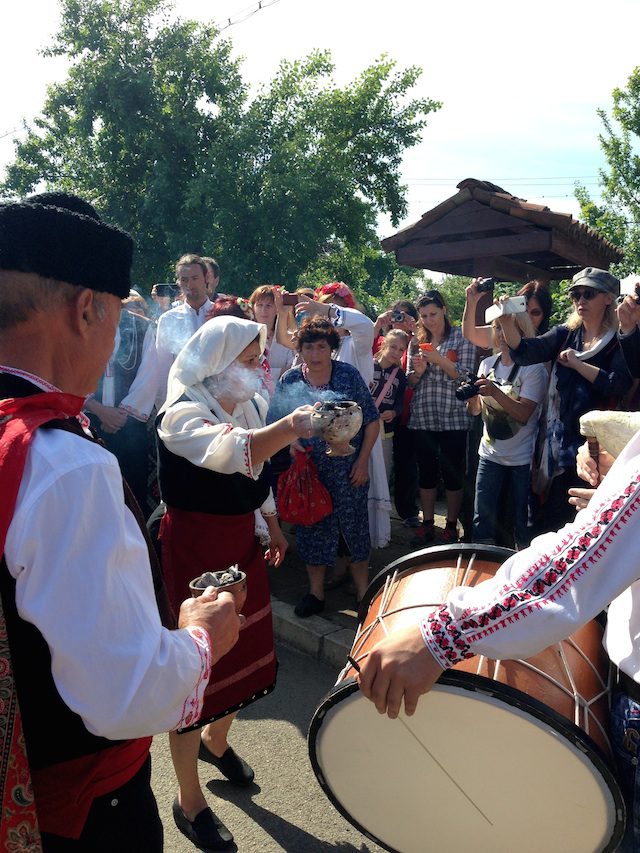
The morning of June 4, 2015 began with a series of prayers in the main church and the ceremonial removal of the icons depicting St. Constantine and Elena (The Byzantine Emperor, Constantine and his mother, Elena). The icons were taken in a solemn procession to the tune of a mesmerizing beat from a drummer and gaida (Bulgarian bagpipe) player. First, the local priest and a number of important participants, including the head nestinarka, or female coal-walker, led a small crowd to a chapel across the main square. There a series of rituals were performed, including a kurban or sacrifice of a sheep by the local priest. The procession continued, with the nestinarka carrying a vessel with burning embers, down a wooded path to a glen where a well and a small chapel were nestled. While blessings took place around the well, icons were placed in a small structure for those assembled to file pass, view, and kiss. Eventually the gathering dissipated until noon, when a huge bonfire was lit in the village square, with an accompanying horo (circle dance) to drumming and bagpipes. By evening folk singers and dancers were featured on an adjacent stage and the square begin to fill with hundreds of people, mostly Bulgarians. As live Bulgarian folk music was pumped over a loudspeaker, a line of hundreds of people snaked around the village square while the bonfire burned down to glowing coals.
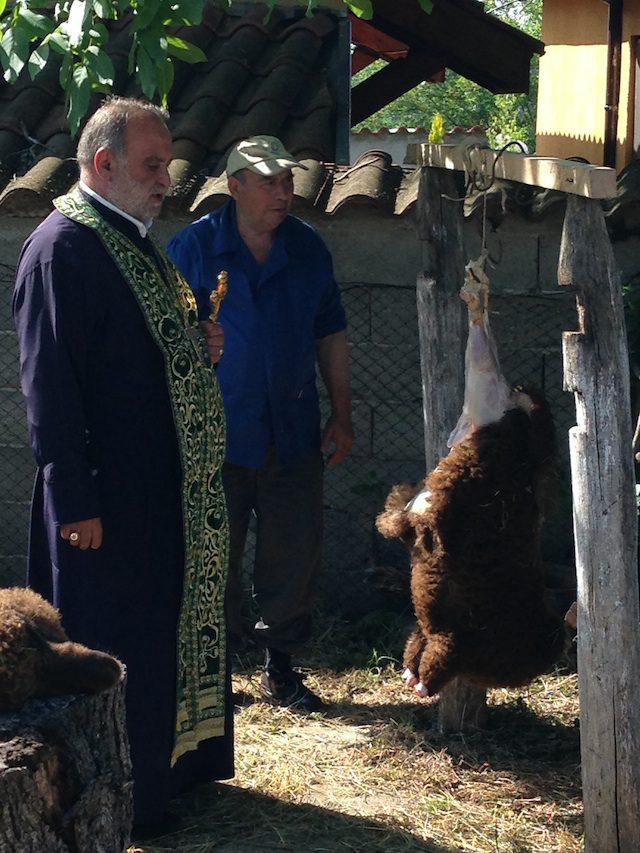
Finally, at a little after ten o’clock, the red hot coals were raked out into a starfish shape in the center of the square, with the crowd on all sides pushing against a protective rope. Suddenly the only music was the single drum and bagpipe and three women and three men began to dance across the burning embers. In a trance-like state they moved rhythmically back and forth across the coals to the drumming and bagpipes, icons in hand – held high overhead—a large crown oohing and ahing.
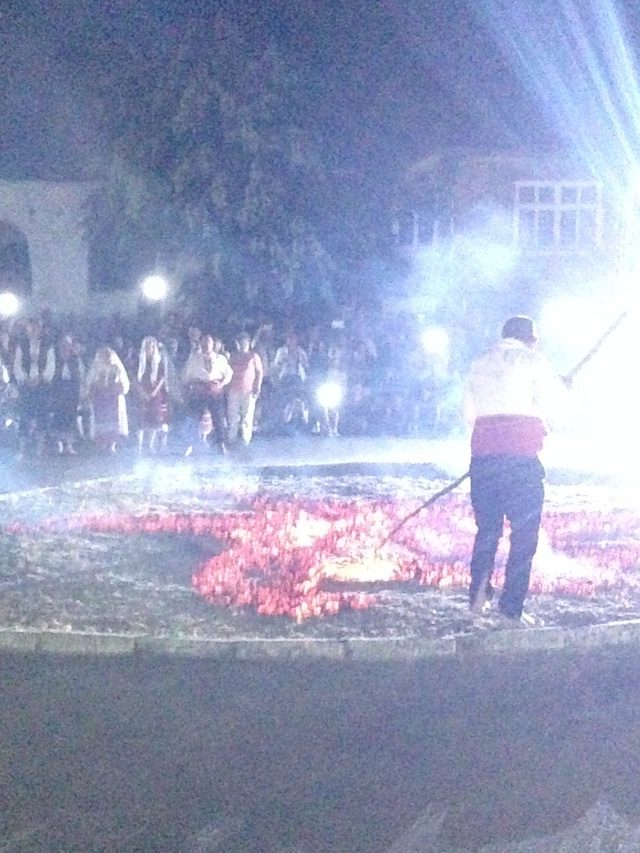
It may be possible to explain how people can walk on hot coals, but I am more interested in the layers of historical sediment that surround the event. First there is the notion that this ritual has been practiced for thousands of years and the current commitment to honor, if not partially reinvent, that tradition. But even more interesting for my current work is the ways in which the event became a site for the intrepid tourist pilgrimage. By the interwar period it is featured in numerous travelogues, and a form of the practice was featured at Black Sea tourist hotels in the communist period. As a site for local tourist observation and participation, the nestinarstvo was and still is deeply connected to food and drink. For example, as chronicled in Ikons and Oxen, Philip Thornton and his resolute party, traveling in 1938, bring to Bulgari a cook from their Black sea hotel and, “Ten pounds of lamb, a gallon of red wine, five bunches of onions and two of carrots, a bottle of butter, a three-pound bag of rice, and a pound of salt.” The salt, the cook explained to Thornton, was to trade to locals for use of their hearths to cook the hearty lamb stew, which they washed down with tasty local wine.
Food and drink were more than just sustenance and pleasure for the traveling visitors. They were (and still are) deeply implicated in the day’s events and rituals. Food was always central in pagan religious rituals and feasting and fasting were deeply embedded in Orthodox Christianity. St. Constantine and Elena Day was a feast day, in which locals pitched in to purchase the kurban, or animal for sacrifice, that was later eaten by the nestinari and others in attendance. Bread has also historically been part of the day’s ritual, and this time pieces of a large loaf were offered to all present at the morning ceremony. Today, a whole street of food vendors catered to tourists and pilgrims who ate and drank throughout the whole day. The ritual feasting included a lamb roasting all day on a spit, a range of other grilled meats, breads, traditional local salads of cucumber, tomato and feta, and generous amounts of local wines, plum brandy, and beer.
Wine has been produced in this region of Bulgaria, which is part of the larger region of Thrace, since ancient times. This is, in fact, the land of the cult of Dionysus (or Bacchus), the Greek (and Roman) God of wine and pleasure. Even more so than food, alcohol consumption is the subject of enjoyment, but also intense scrutiny by foreigners and locals in the period I study. In addition to the cult of Bacchus, this region was also the source of the 11th century Bogomil heresy – one of the first “Proto-Protestant” rebellions against the decadence of the established Christian church. Among other things, the Bogomils practiced temperance and vegetarianism, and as such were a cult of restraint in all manners of consumption. Eradicated by the Byzantines in the 13th century, the “Bogomil legacy” seemed to live on, according to foreign travelers, among other Slavic “fanatics,” including the largest Tolstoyan movement established outside of Russia in early twentieth century. In fact, the Bulgarian village of “Yasna Polyana,” was not far from Bulgari in the Strandja region. Bulgarians set up a commune here in 1908, naming it after Tolstoy’s commune and estate in Russia, Yasnaya Polyana and where they published many of Tolstoy’s works that were banned in Russia. This summer I visited Yasna Polyana, where a recently consecrated bust of Tolstoy presides on the main square.
Bulgari and Yasna Polyana serve as different kinds of markers on what Ivan Hadzhiiski, the founder of Bulgarian sociology, called the “moral map of Bulgaria.” His copious writings from the 1930s, charted the contours of Bulgarian everyday life.. As he rightly notes, the morals of “gastronomy” were defining features of Bulgarian tradition, as well as its transition to modernity. Of course this is not just for Bulgarians. As my favorite historian of food, Felipe Fernández-Armesto notes in his Near a Thousand Tables, food “matters most to most people for most of the time.” The words of Armesto, like Hadzhiiski, accompanied me on my tour, from town to town, from table to table.
You may also like:
Mary Neuburger on Tobacco and Smoking in Bulgaria and on Cigarettes during the Cold War
_________________________________________________________________________________________
The views and opinions expressed in this article or video are those of the individual author(s) or presenter(s) and do not necessarily reflect the policy or views of the editors at Not Even Past, the UT Department of History, the University of Texas at Austin, or the UT System Board of Regents. Not Even Past is an online public history magazine rather than a peer-reviewed academic journal. While we make efforts to ensure that factual information in articles was obtained from reliable sources, Not Even Past is not responsible for any errors or omissions.

